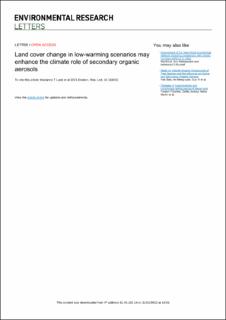| dc.contributor.author | Lund, Marianne Tronstad | |
| dc.contributor.author | Rap, Alexandru | |
| dc.contributor.author | Myhre, Gunnar | |
| dc.contributor.author | Søvde, Ole Amund | |
| dc.contributor.author | Samset, Bjørn Hallvard | |
| dc.date.accessioned | 2022-01-31T13:41:21Z | |
| dc.date.available | 2022-01-31T13:41:21Z | |
| dc.date.created | 2021-12-08T00:15:33Z | |
| dc.date.issued | 2021 | |
| dc.identifier.citation | Environmental Research Letters. 2021, 16 (10), 1-11. | en_US |
| dc.identifier.issn | 1748-9326 | |
| dc.identifier.uri | https://hdl.handle.net/11250/2976046 | |
| dc.description.abstract | Most socioeconomic pathways compatible with the aims of the Paris Agreement include large changes to land use and land cover. The associated vegetation changes can interact with the atmosphere and climate through numerous mechanisms. One of these is emissions of biogenic volatile organic compounds (BVOCs), which may lead to the formation of secondary organic aerosols (SOAs) and atmospheric chemistry changes. Here, we use a modeling framework to explore potential future global and regional changes in SOA and tropospheric ozone following idealized, large-scale vegetation perturbations, and their resulting radiative forcing (RF). Guided by projections in low-warming scenarios, we modify crop and forest cover, separately, and in concurrence with changes in anthropogenic emissions and CO2 level. We estimate that increasing global forest cover by 30% gives a 37% higher global SOA burden, with a resulting forcing of −0.13 W m−2. The effect on tropospheric ozone is relatively small. Large SOA burden changes of up to 48% are simulated for South America and Sub-Saharan Africa. Conversely, increasing crop cover at the expense of tropical forest, yields similar changes but of opposite sign. The magnitude of these changes is strongly affected by the concurrent evolution of anthropogenic emissions. Our land cover perturbations are representative of energy crop expansion and afforestation, two key mitigation measures in 1.5 °C compatible scenarios. Our results hence indicate that depending on the role of these two in the underlying mitigation strategies, scenarios with similar long-term global temperature levels could lead to opposite effects on SOA. Combined with the complexity of factors that control SOA, this highlights the importance of including BVOC effects in further studies and assessments of climate and air quality mitigation involving the land surface. | en_US |
| dc.language.iso | eng | en_US |
| dc.publisher | IOP Publishing | en_US |
| dc.rights | Navngivelse 4.0 Internasjonal | * |
| dc.rights.uri | http://creativecommons.org/licenses/by/4.0/deed.no | * |
| dc.title | Land cover change in low-warming scenarios may enhance the climate role of secondary organic aerosols | en_US |
| dc.type | Peer reviewed | en_US |
| dc.type | Journal article | en_US |
| dc.description.version | publishedVersion | en_US |
| dc.source.pagenumber | 1-11 | en_US |
| dc.source.volume | 16 | en_US |
| dc.source.journal | Environmental Research Letters | en_US |
| dc.source.issue | 10 | en_US |
| dc.identifier.doi | 10.1088/1748-9326/ac269a | |
| dc.identifier.cristin | 1965860 | |
| dc.relation.project | Norges forskningsråd: 244074 | en_US |
| dc.relation.project | Norges forskningsråd: 254966) | en_US |
| cristin.ispublished | true | |
| cristin.fulltext | original | |
| cristin.qualitycode | 2 | |

